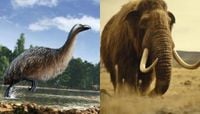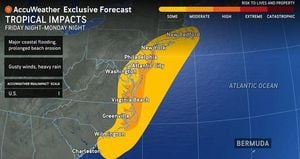New Zealand, an island nation famed for its breathtaking landscapes and unique wildlife, has long been locked in a battle to protect its fragile ecosystem from outside threats. From the moment travelers arrive, they encounter a formidable biosecurity process: beagles patrol airport terminals, sniffing out contraband like seeds, honey, and fruit, while border agents meticulously spray down camping gear to kill contaminants. The message is clear, as Air New Zealand’s in-flight video puts it: “This fragile place is all we’ve got. …That’s why we guard it.”
It’s easy to see why. Before humans set foot on these islands, flightless birds like the kākāpō and kiwi flourished, and the only native mammal was a bat. But the arrival of the Māori about 800 years ago, bringing dogs and rats, marked the beginning of an ecological upheaval. European settlers only accelerated the damage, introducing possums for fur, rabbits for sport, and stoats to manage the rabbit population—predators that would devastate native species. According to Slate, so-called “acclimatization societies” even released hedgehogs to make New Zealand feel more like Britain, with disastrous results for native wildlife.
The consequences have been staggering. Nearly half of New Zealand’s vertebrate species have vanished since humans arrived. Each year, imported predators destroy an estimated 25 million birds, chicks, and eggs, while 30 million possums consume 21,000 tons of vegetation nightly, severely depleting food for native animals. As the New Zealand Department of Conservation notes, even a single hedgehog “can cause an entire colony of endangered black-fronted terns to abandon their nests.”
Recognizing the crisis, the New Zealand government launched the ambitious Predator Free 2050 campaign in 2016, investing $28 million to eradicate all introduced predators by mid-century. The movement has since grown, with increased funding and widespread participation. More than 100 offshore islands are now predator-free and over 80 eco-sanctuaries shield native ecosystems. In Dunedin, on the South Island, Predator Free Dunedin has set over 6,300 traps since 2018, eliminating more than 50,000 predators like possums, rats, hedgehogs, and stoats. The collective effort is paying off: native birds such as kererū and tūī are making a comeback, and once-overrun habitats are slowly recovering.
Yet, just as New Zealanders double down on these gritty, hands-on conservation efforts, a bold new proposal has emerged—one that’s sparking both excitement and controversy. In July 2025, Texas-based biotech company Colossal Biosciences announced plans to “de-extinct” the moa, a colossal flightless bird that once towered 12 feet tall and weighed up to 500 pounds before being hunted to extinction by Māori settlers about 600 years ago. The project is being promoted in partnership with acclaimed film director Sir Peter Jackson, best known for his work on Lord of the Rings, who appears in a glossy promotional video declaring, “being extinct isn’t really the end of the story.”
Colossal Biosciences is no stranger to headline-grabbing projects. According to Livescience and Slate, the company previously made waves by claiming to have resurrected the ice-age dire wolf. In reality, what they produced were gray wolves with 20 gene edits to mimic the appearance of dire wolves—creatures that now live on a 2,000-acre preserve surrounded by zoo-grade fencing. Their approach, as chief science officer Beth Shapiro explained, relies on the “morphological species concept”: if an animal looks like its extinct counterpart, it is treated as such. Critics, however, liken this to painting a cat to look like a fox and declaring it a fox.
The moa project follows a similar path. Rather than cloning a true moa, Colossal Biosciences plans to edit the genes of a close living relative—such as the emu or tinamou—creating a bird that resembles the extinct moa but is, in fact, a hybrid. The company does not intend to release these birds into the wild; instead, they’ll be kept in large, enclosed naturalistic habitats. As Sir Peter Jackson puts it, the goal is to provide “a natural environment as big as we possibly can” for the flock. But in a country the size of Colorado, critics argue, even these enclosures may take up valuable space needed by native species still fighting for survival.
The campaign is coordinated with the Ngāi Tahu Research Centre, a group focused on fostering Indigenous scholarship and conservation. Archaeologist Kyle Davis of the centre told Livescience, “Some of those iconic species that in our tribal mythology, our storytelling, are very near and dear to us. Participating in scientific research, species management, and conservation has been a large part of our activities.” The project is pitched as an effort to restore hope and cultural heritage to Māori communities, with promotional materials featuring traditional poi dances and the haka, a ceremonial war dance. Yet, as Slate points out, Māori make up nearly 18 percent of New Zealand’s population, and their views are far from monolithic. While some may feel a deep connection to the moa, others may see the project as less relevant to their modern lives, which often revolve around pressing issues like housing and health.
Proponents of the moa’s return argue that it could inspire conservation and draw attention to the plight of New Zealand’s critically endangered species. Colossal Biosciences claims that their work is conservation, not spectacle. In their view, de-extinction projects can “supercharge” efforts to protect what remains and rehabilitate lost cultural heritage. The company is also working on resurrecting woolly mammoths, aiming to use similar genetic techniques to fill gaps in extinct species’ DNA with that of modern relatives.
But not everyone is convinced. Experts warn that the de-extinction process is fraught with challenges and risks. As Slate notes, the laboratory-created “moa” would be a new creature with unpredictable behavior. If it were ever to escape its enclosure, it could wreak havoc on native ecosystems—much as previous introduced species have done. “If an animal the size of a hedgehog can devour our native plants and insects, including the endemic and endangered wētā,” one commentator mused, “imagine what a mixed-gene bird the size of an emu could do as it crashes around the bush.”
For some, the allure of de-extinction is a kind of species nostalgia—a fantasy of undoing the damage of the past with a technological fix. But as New Zealand faces the reality of the planet’s sixth mass extinction, many conservationists argue that the best path forward is the unglamorous, painstaking work of protecting what’s left: setting and checking traps, replanting native bush, and maintaining strict biosecurity. As one volunteer put it, “We know these animals are not malevolent, just trying to survive, and so the traps dispatch them with as little suffering as possible. They work.”
As the debate rages on, New Zealanders continue their daily fight to hold the line against extinction. Whether the moa’s return will be a beacon of hope or a costly distraction remains to be seen. For now, the nation’s conservationists are keeping their focus on the hard, muddy work that’s already yielding results—and on making sure that what’s left of their natural heritage doesn’t become just another memory.




